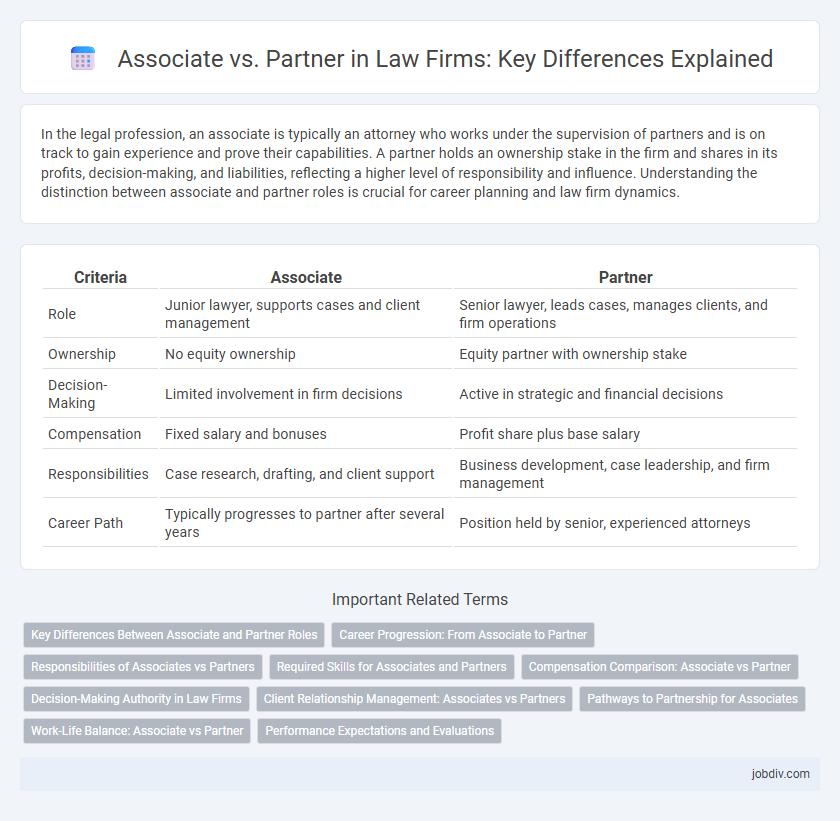In the legal profession, an associate is typically an attorney who works under the supervision of partners and is on track to gain experience and prove their capabilities. A partner holds an ownership stake in the firm and shares in its profits, decision-making, and liabilities, reflecting a higher level of responsibility and influence. Understanding the distinction between associate and partner roles is crucial for career planning and law firm dynamics.
Table of Comparison
| Criteria | Associate | Partner |
|---|---|---|
| Role | Junior lawyer, supports cases and client management | Senior lawyer, leads cases, manages clients, and firm operations |
| Ownership | No equity ownership | Equity partner with ownership stake |
| Decision-Making | Limited involvement in firm decisions | Active in strategic and financial decisions |
| Compensation | Fixed salary and bonuses | Profit share plus base salary |
| Responsibilities | Case research, drafting, and client support | Business development, case leadership, and firm management |
| Career Path | Typically progresses to partner after several years | Position held by senior, experienced attorneys |
Key Differences Between Associate and Partner Roles
Associate roles primarily involve case research, client interaction under supervision, and supporting partners through legal documentation and preparation. Partners hold ownership stakes in the firm, drive business development, make strategic decisions, and oversee associates' work to ensure quality and profitability. The remuneration structure differs significantly; associates receive fixed salaries and bonuses, while partners earn profit shares aligned with firm performance.
Career Progression: From Associate to Partner
Career progression in law firms typically starts with associates who handle casework and develop legal skills under partner supervision. Over several years, associates demonstrate expertise, business development capabilities, and leadership qualities critical for partnership consideration. Promotion to partner signifies a transition from employee to co-owner, granting decision-making authority and a share in firm profits.
Responsibilities of Associates vs Partners
Associates primarily handle legal research, drafting documents, and supporting partners in case preparation, often managing specific tasks under supervision. Partners bear full responsibility for client relationships, strategic decision-making, and overall case outcomes, including firm management and business development. The division of responsibilities reflects a transition from task execution to leadership and accountability within the firm.
Required Skills for Associates and Partners
Associates require strong analytical abilities, effective communication skills, and proficiency in legal research to support case preparation and client interactions. Partners must demonstrate advanced leadership, business development acumen, and strategic decision-making capabilities to manage firm operations and cultivate client relationships. Both roles demand expertise in negotiation and a deep understanding of relevant legal regulations and industry standards.
Compensation Comparison: Associate vs Partner
Associates typically receive a fixed salary with performance bonuses, while partners earn a share of the firm's profits, resulting in significantly higher potential compensation. Partner compensation varies widely based on equity status and firm profitability, often including profit distributions alongside base draws. In contrast, associates have limited upside and fewer financial incentives tied directly to firm revenue.
Decision-Making Authority in Law Firms
Associates in law firms typically have limited decision-making authority, mainly supporting partners through research, drafting, and client interaction under supervision. Partners hold significant decision-making power, including strategic firm management, client acquisition, case direction, and financial oversight. The distinction in authority impacts firm hierarchy, responsibility allocation, and career progression within legal practices.
Client Relationship Management: Associates vs Partners
Associates primarily support client relationship management by conducting research, preparing documents, and maintaining communication under supervision, allowing partners to lead strategic client engagements. Partners hold ultimate responsibility for client relationships, driving business development, negotiating agreements, and ensuring client satisfaction to secure long-term partnerships. Effective client relationship management relies on the collaboration between associates' detailed support and partners' leadership roles in legal service delivery.
Pathways to Partnership for Associates
Associates in law firms typically progress to partnership through demonstrated expertise, consistent billable hours, and strong client relationship management. Firms evaluate potential partners based on leadership skills, business development capabilities, and contributions to firm growth. Structured mentorship programs and formalized partnership tracks often support associates in achieving equity or non-equity partnership status.
Work-Life Balance: Associate vs Partner
Associates often experience more structured hours with clearer expectations, enabling a relatively better work-life balance compared to partners, who typically face unpredictable schedules due to client demands and leadership responsibilities. Partners carry the added pressure of business development and firm management, resulting in longer hours and less personal time. Effective delegation and firm support systems are crucial for partners striving to maintain any work-life balance.
Performance Expectations and Evaluations
Associates in law firms are typically evaluated based on billable hours, client development efforts, and attention to detail in legal research and drafting, with a strong emphasis on meeting predefined performance metrics. Partners are assessed on their ability to generate business, manage client relationships, contribute to firm strategy, and lead teams, reflecting broader responsibilities beyond individual case work. Performance evaluations for both roles impact compensation, promotion prospects, and long-term firm alignment, with partners often subject to peer review and partnership committee assessments.
Associate vs Partner Infographic

 jobdiv.com
jobdiv.com